When creating a Behavior Intervention Plan (BIP), it’s paramount to involve the individual for whom the BIP is being crafted. Their insights can offer invaluable information about triggers and effective coping strategies. Moreover, gathering input from close associates, like parents, friends, or anyone closely associated with the individual, can further enrich the BIP’s effectiveness.
A BIP should have clear objectives that define which behaviors need modification and what the desired outcomes are. Once the BIP is in place, it’s crucial to consistently implement it and periodically review its effectiveness, making necessary adjustments as needed.
Applications of Behavior Intervention Plans (BIPs)
BIPs find applications in various settings. In educational settings, for instance, teachers and school psychologists deploy BIPs to handle disruptive behaviors in the classroom, ensuring a conducive learning environment for all students. Therapists, in therapeutic settings, leverage BIPs to modify their client’s behaviors, using techniques that are suited for the therapeutic context. Similarly, in homes, parents can adopt BIPs to address their child’s problematic behaviors, fostering harmonious family dynamics.
Creating an Effective BIP
The success of a BIP largely depends on its formulation. A generic plan might not address the specific needs of an individual. Hence, it’s crucial to create a BIP tailored to the individual’s preferences, strengths, and challenges.
Here are some steps to guide the creation process:
- Involve the Individual: Always involve the person for whom the BIP is being created. Their insights can provide invaluable information about triggers and effective coping strategies.
- Gather Input from Close Associates: Parents, friends, or anyone closely associated with the individual can offer additional insights, enriching the BIP’s effectiveness.
- Set Clear Objectives: Define what behaviors need modification and what the desired outcomes are.
- Implement and Review: Once the BIP is in place, it’s essential to consistently implement it and periodically review its effectiveness, making necessary adjustments.
Advantages of Using BIP Templates
Utilizing BIP templates offers several benefits. For one, templates present findings, like FBA observations, in a consistent format, making it easier for all stakeholders to understand and implement. Templates also expedite the BIP drafting process, reducing the time taken to create a plan from scratch. Additionally, a well-structured template ensures that all vital components of a BIP are addressed, minimizing the risk of omitting essential information.
Free Templates
Given below are behavior intervention plan templates:
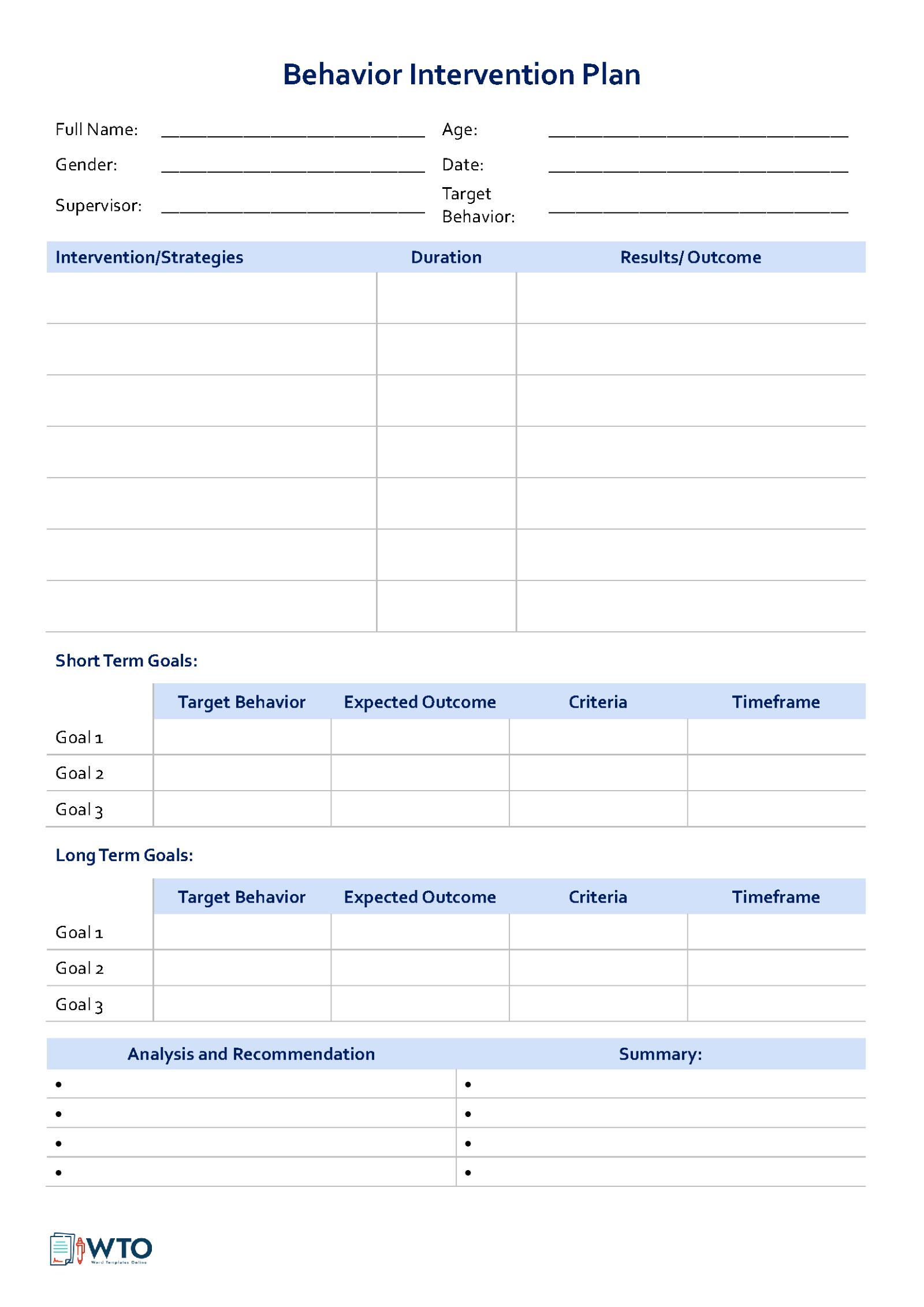
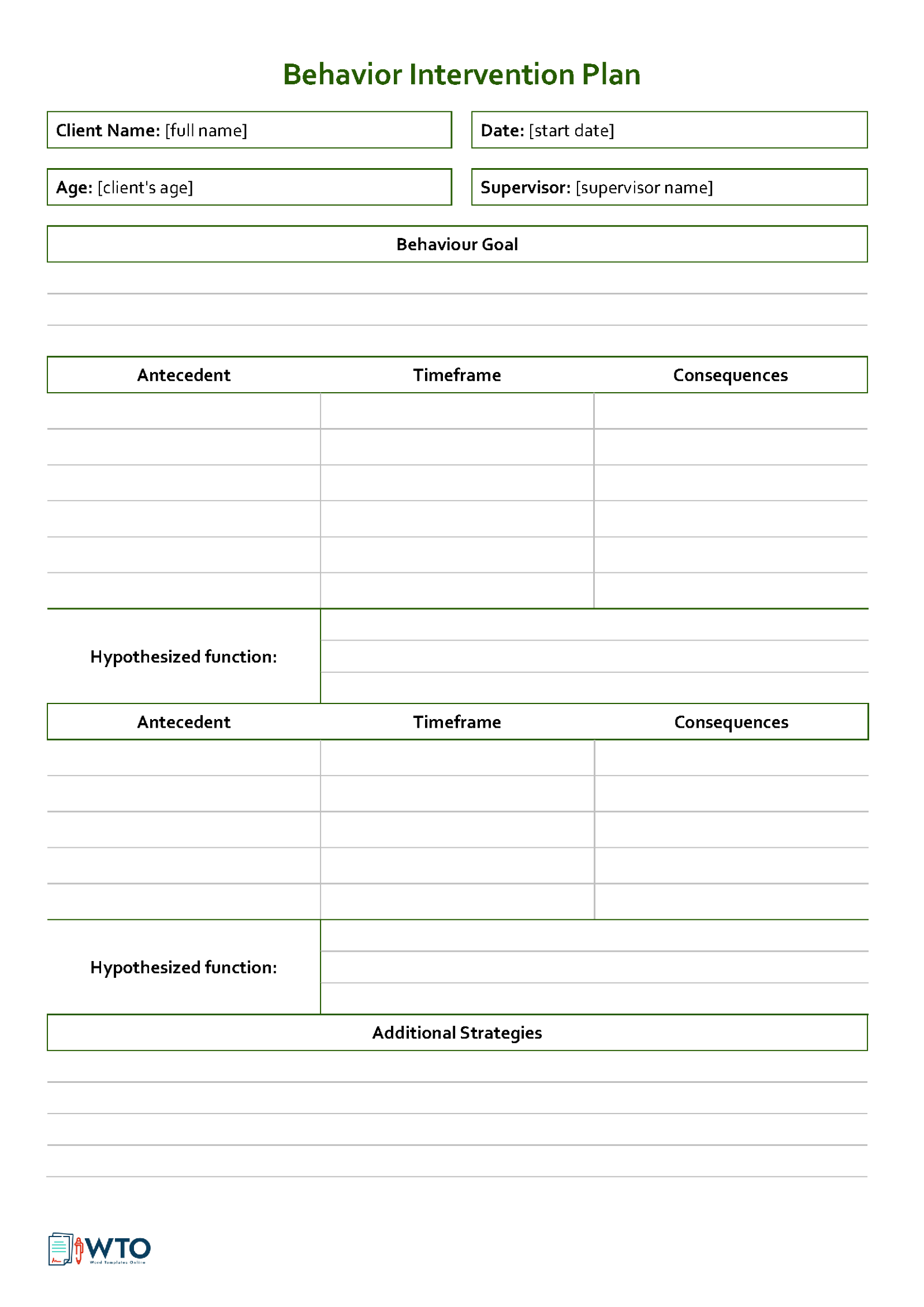
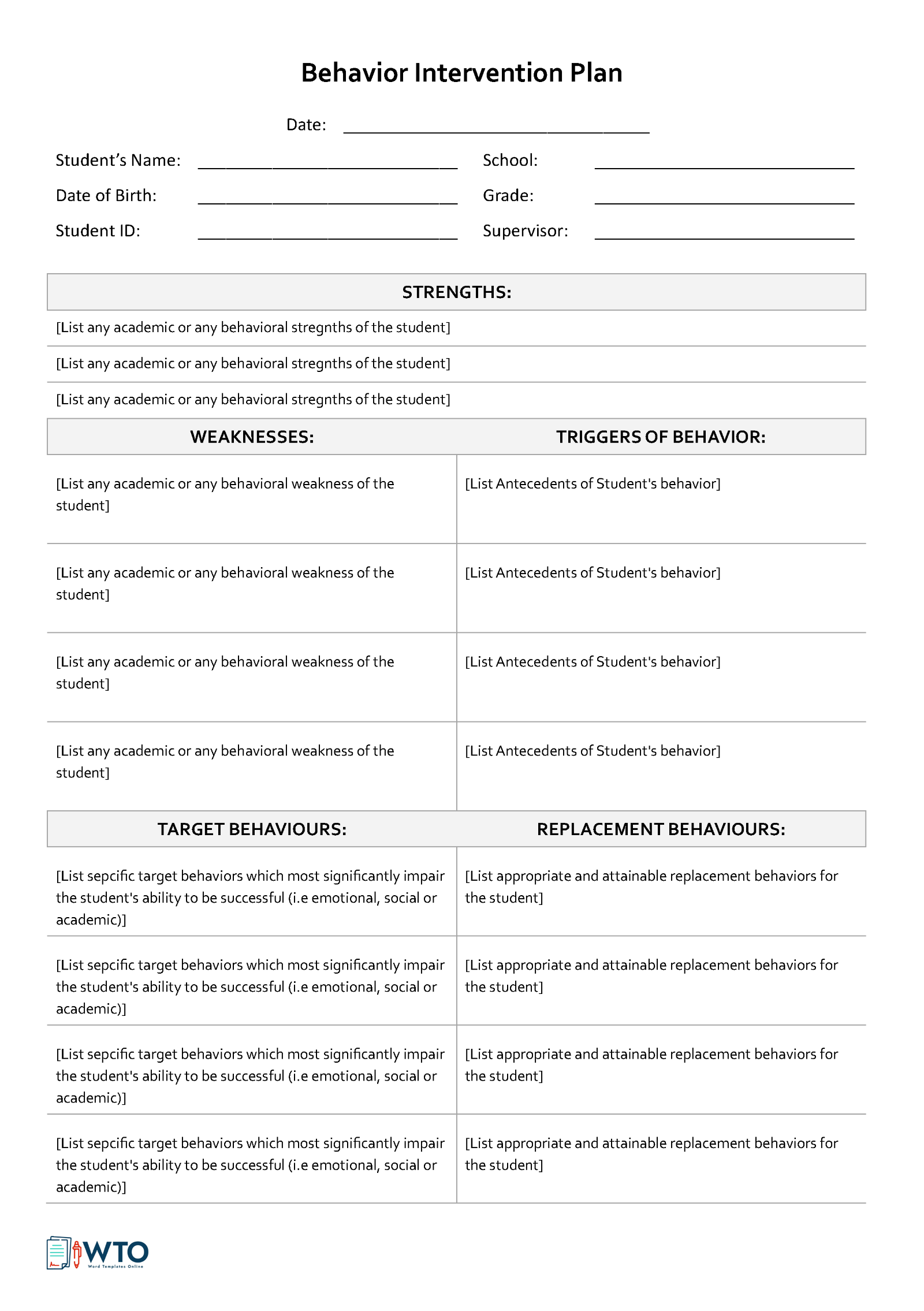
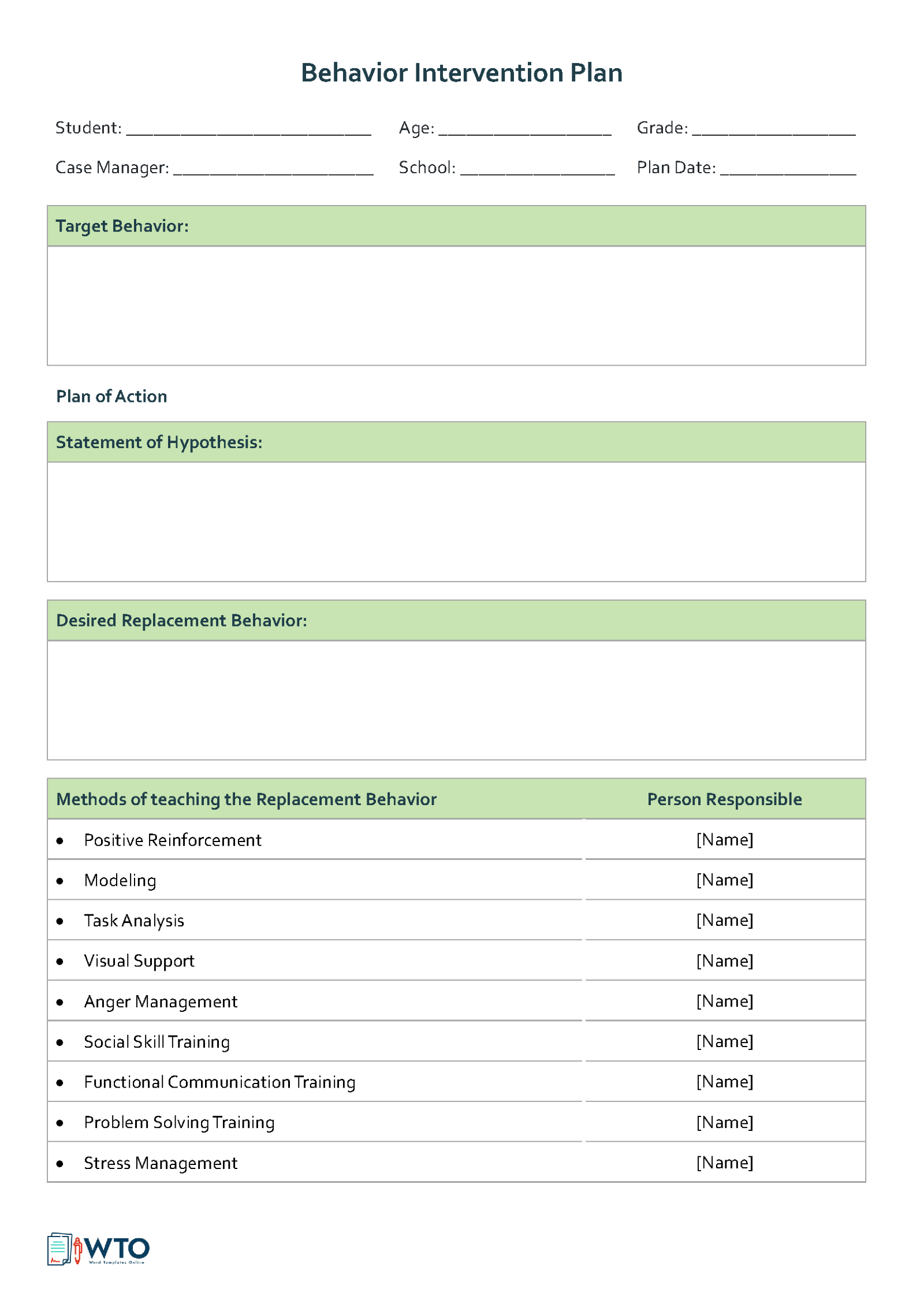
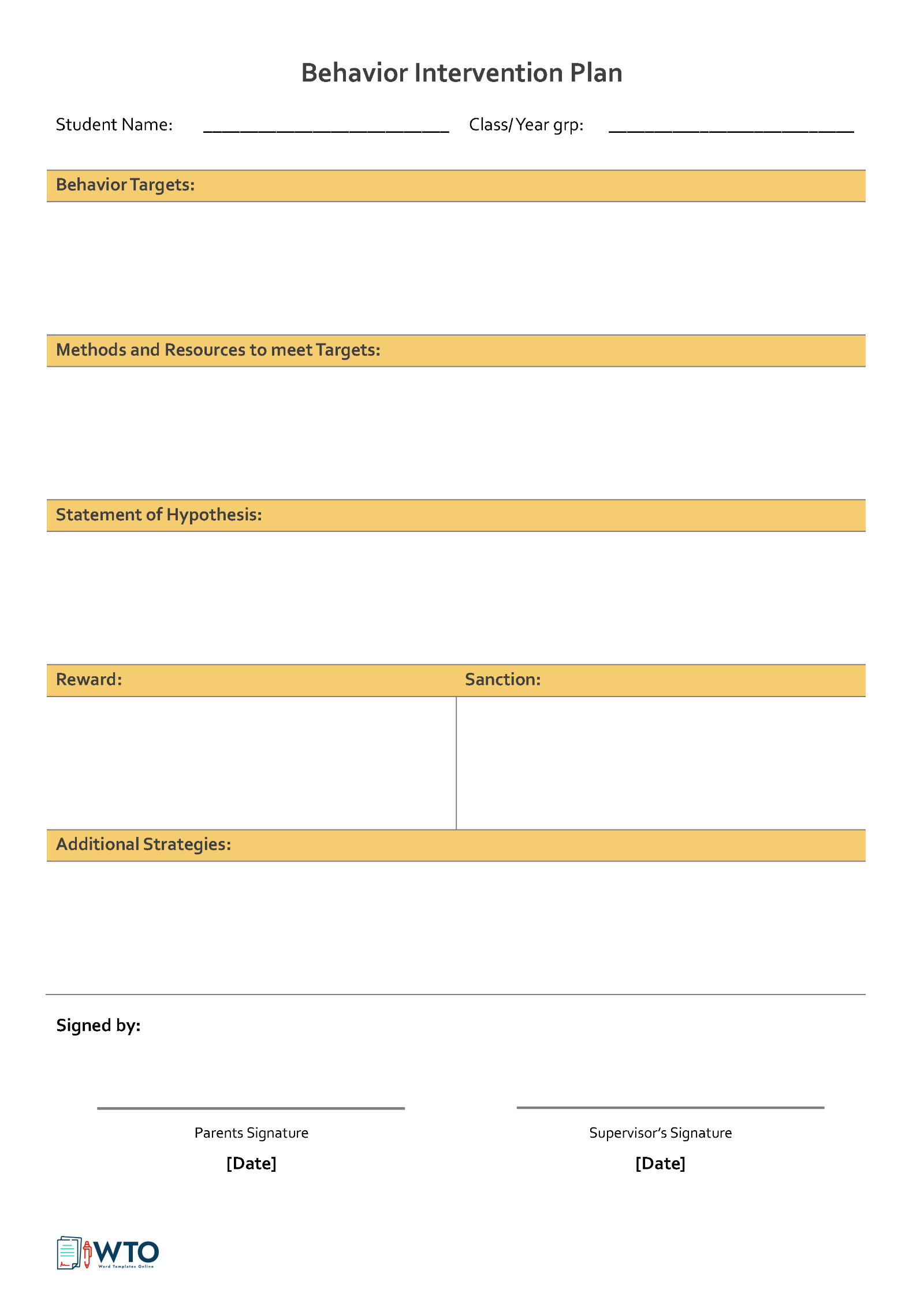
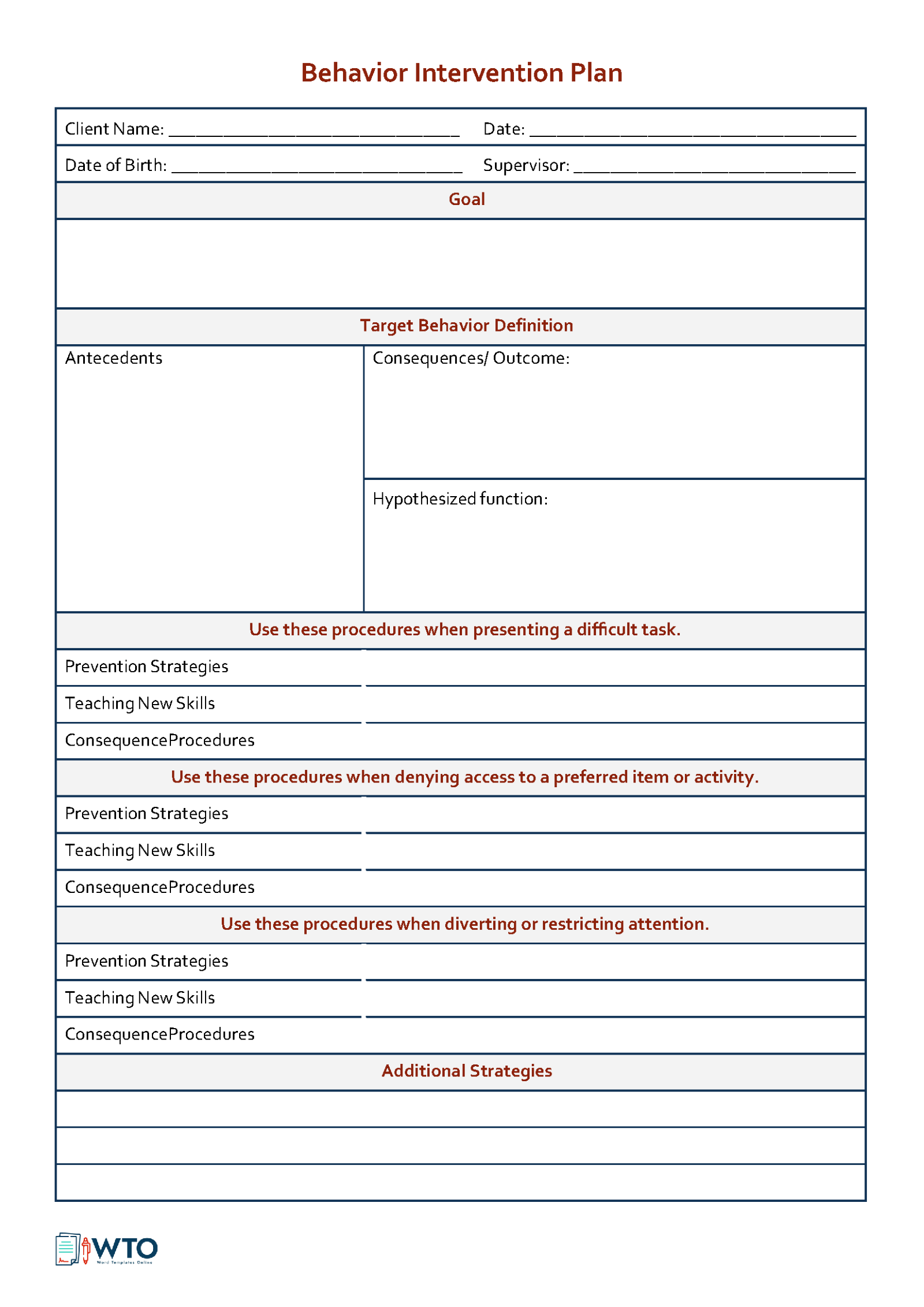
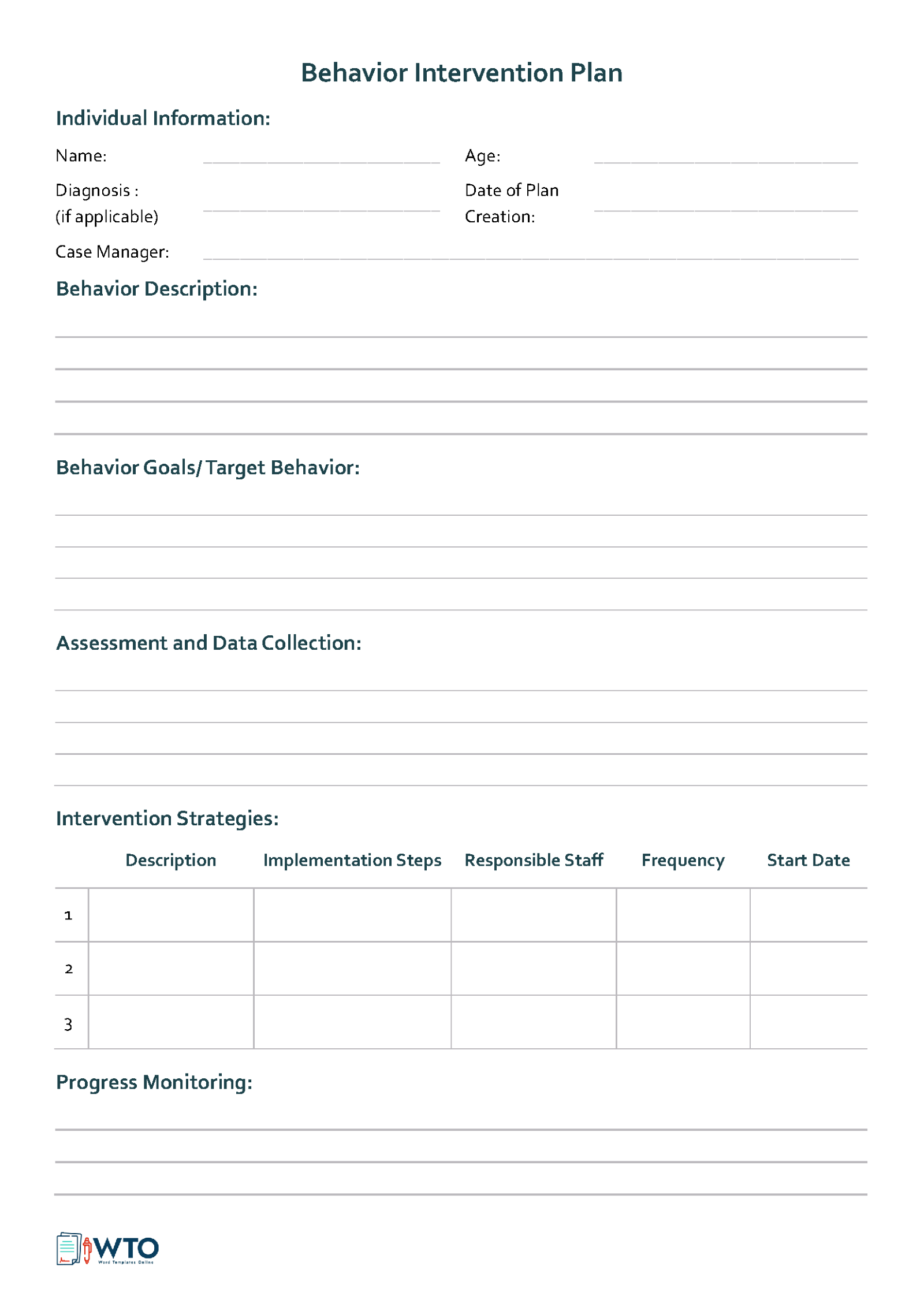
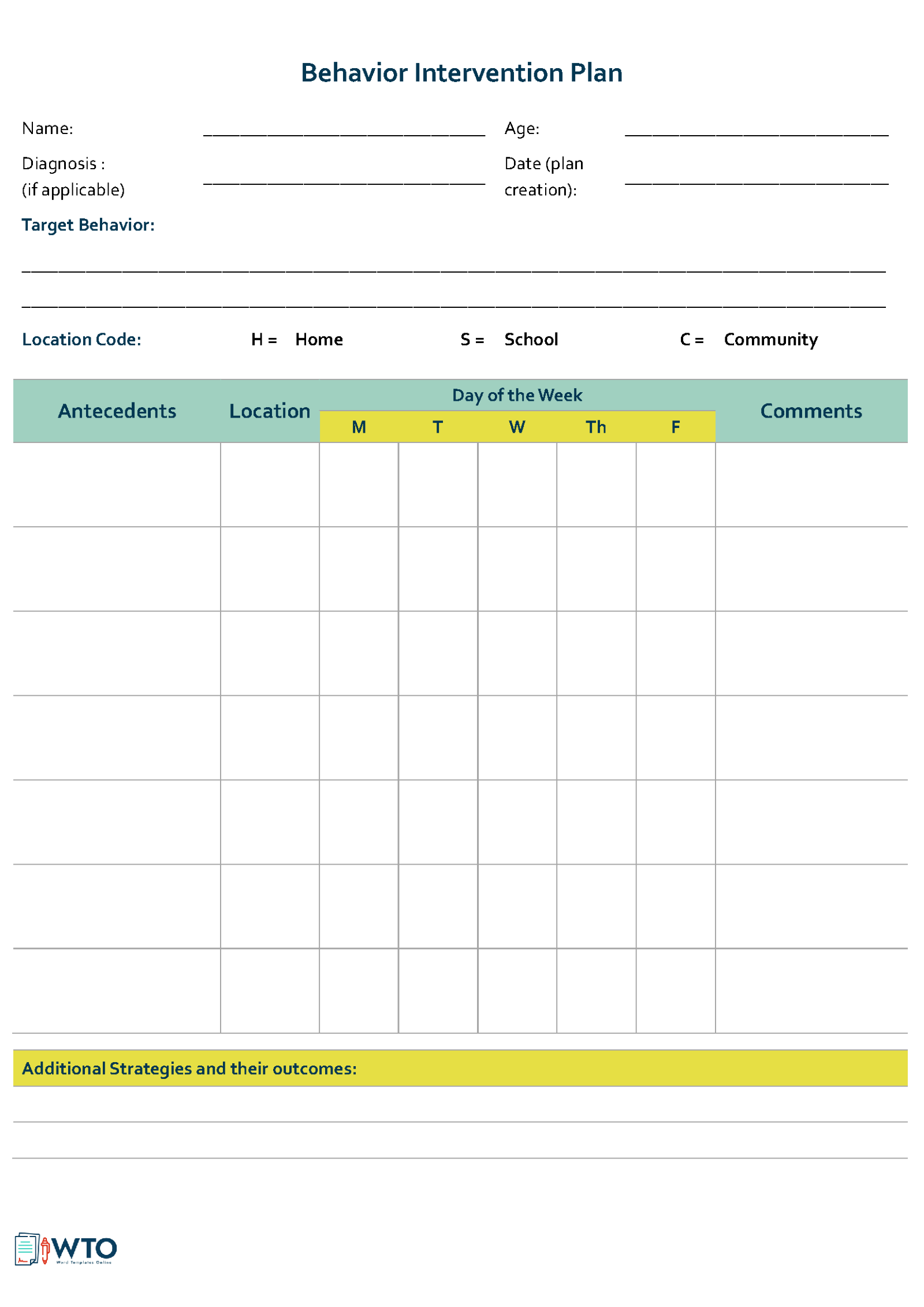
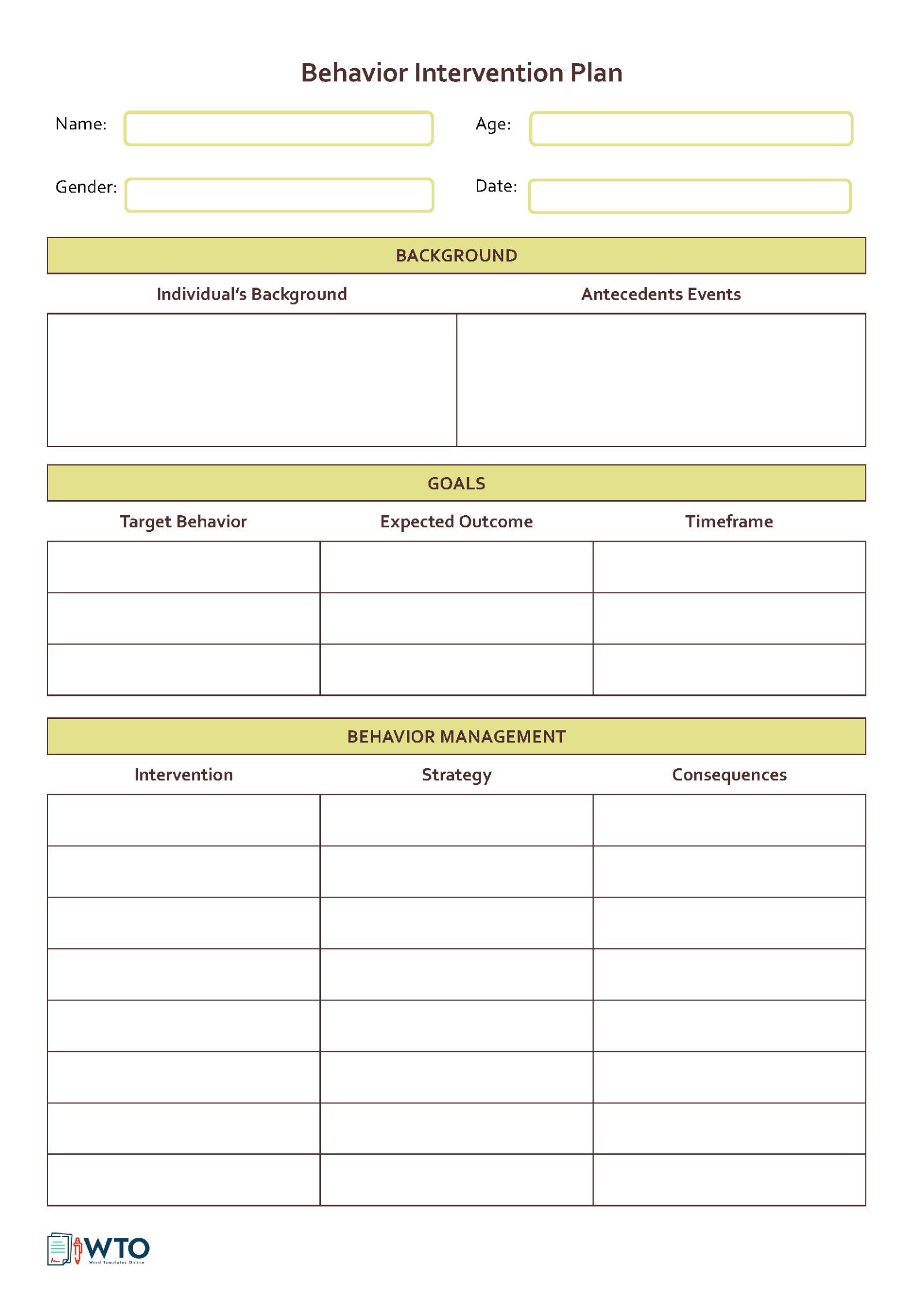
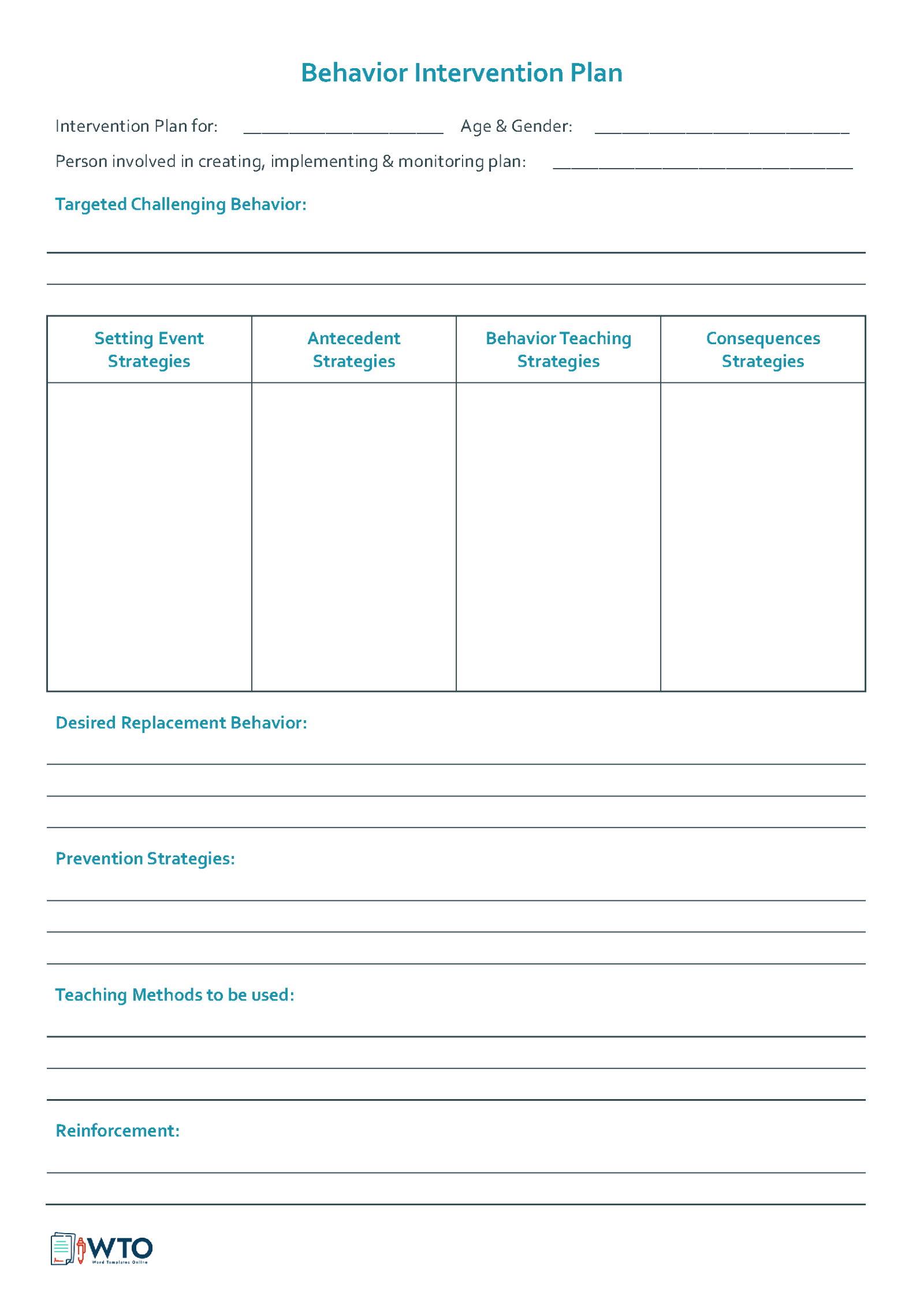
Steps in Crafting a BIP
Crafting a BIP is a systematic process that requires thoroughness at each step to ensure the plan’s effectiveness. The following are the key steps involved in crafting a robust Behavior Intervention Plan:
Functional behavior assessment (FBA)
The first step involves conducting a Functional Behavior Assessment to understand the root cause of the undesired behavior. During an FBA, professionals observe the individual in various settings to identify triggers, consequences, and intentions of the problematic behavior.
Define the behavior
Post assessment, it’s imperative to clearly define the problematic behavior in measurable terms. Instead of a vague label like ‘disruptive’, specifics such as ‘shouting during class three times a day’ offer better clarity.
Choose intervention strategies
Based on the identified causes from the FBA, appropriate intervention methods are selected. These could range from environmental alterations, teaching alternative skills, to deploying reinforcement strategies.
Monitoring and revision
After the BIP’s implementation, the individual’s progress must be consistently monitored. If the outcomes aren’t as anticipated, it’s necessary to revise the strategies to better align with the desired behavioral changes.
Advantages of Using BIP Templates
Using standardized BIP templates brings forth several advantages. Primarily, such templates present findings in a consistent format, making it easier for all stakeholders to understand and implement the documented observations and strategies. This consistency is especially evident in presenting FBA findings:
Efficiency
BIP templates greatly expedite the drafting process. Instead of creating a BIP from scratch, using templates can considerably reduce the time and effort involved, ensuring quick turnarounds.
Comprehensiveness
Well-structured templates have the added advantage of ensuring that all vital components of a BIP are addressed. This minimizes the risk of inadvertently omitting crucial information, leading to a more effective intervention plan.
Practical Example of BIP Steps
To better grasp the BIP creation process, let’s consider a hypothetical scenario:
Student A frequently disrupts class by shouting out answers.
- FBA Findings: Observations reveal that Student A shouts out primarily during math lessons and when sitting near the window. The behavior seems to be a way to gain peer attention.
- Defined Behavior: Student A shouts out answers during math lessons approximately five times per lesson.
- Intervention Strategies: Move Student A’s seat away from the window and closer to the teacher. Introduce a hand-raising system during discussions and praise Student A for waiting their turn. Additionally, create a reward system for days when there are fewer than three shout-outs.
- Monitoring: The teacher notes the frequency of shout-outs daily and discusses progress with Student A weekly.
By following these steps, a tangible change in Student A’s behavior can be expected over time.
Components of a BIP Template
A comprehensive BIP template typically consists of several key components, each crucial to the plan’s effectiveness. These components encompass:
Student/individual information
This section captures basic details such as the individual’s name, age, and other pertinent demographics, providing context to the BIP.
Target behavior
A clear and concise description of the behavior requiring intervention is outlined here, ensuring all stakeholders have a uniform understanding.
Functional behavior assessment summary
Insights derived from the FBA, including identified triggers and consequences of the undesired behavior, are documented in this section.
Behavioral goals
Measurable objectives that outline the desired outcomes post-intervention are detailed here. These goals serve as benchmarks to gauge the BIP’s effectiveness.
Intervention strategies
This section enumerates specific strategies and techniques to be employed to address the target behavior, ensuring a systematic approach to behavior modification.
Supports and resources
Any additional resources or supports essential for the intervention, such as special tools, materials, or external expert consultations, are listed here.
Review and monitoring plan
A clear schedule for periodic reviews and updates on the BIP’s effectiveness ensures that the plan remains relevant and adaptable to changing circumstances.
Adapting BIP Templates for Various Settings
While standardized BIP templates offer a structured approach, it’s often necessary to adapt them to fit various settings and individual needs. Key considerations while adapting a BIP template include:
Personalize demographics
Ensuring that the template accurately captures all relevant personal details of the individual is crucial for context and specificity.
Adapt sections
Depending on the specific setting (e.g., school, home, therapy), certain sections of the template might need more emphasis, addition, or even removal to tailor the BIP appropriately.
Incorporate feedback
Feedback from stakeholders, such as teachers, parents, or therapists, is invaluable. Regularly gathering and incorporating this feedback refines the template, ensuring it remains relevant and effective.
How to Use a BIP Template
Using a BIP template effectively ensures that the intervention plan is comprehensive and actionable. Here’s a step-by-step guide on how to leverage a BIP template:
Download and review
Begin by downloading a suitable BIP template and familiarizing yourself with its various sections. This preliminary review provides a roadmap for the subsequent steps.
Gather information
Before populating the template, gather all necessary data and insights, especially findings from the FBA, to ensure the BIP is evidence-based.
Fill out the template
Populate each section of the template diligently, ensuring that the information is both accurate and comprehensive. This step transforms the generic template into a personalized intervention plan.
Review with stakeholders
Once the BIP is drafted, it’s imperative to review it with relevant stakeholders, such as teachers, parents, or therapists. Their feedback can offer additional insights and validate the proposed strategies.
Implement and monitor
With the BIP finalized, it’s time to put it into action. Implementation should be consistent, and its efficacy should be monitored regularly. If the plan isn’t delivering the desired results, timely revisions are essential.




